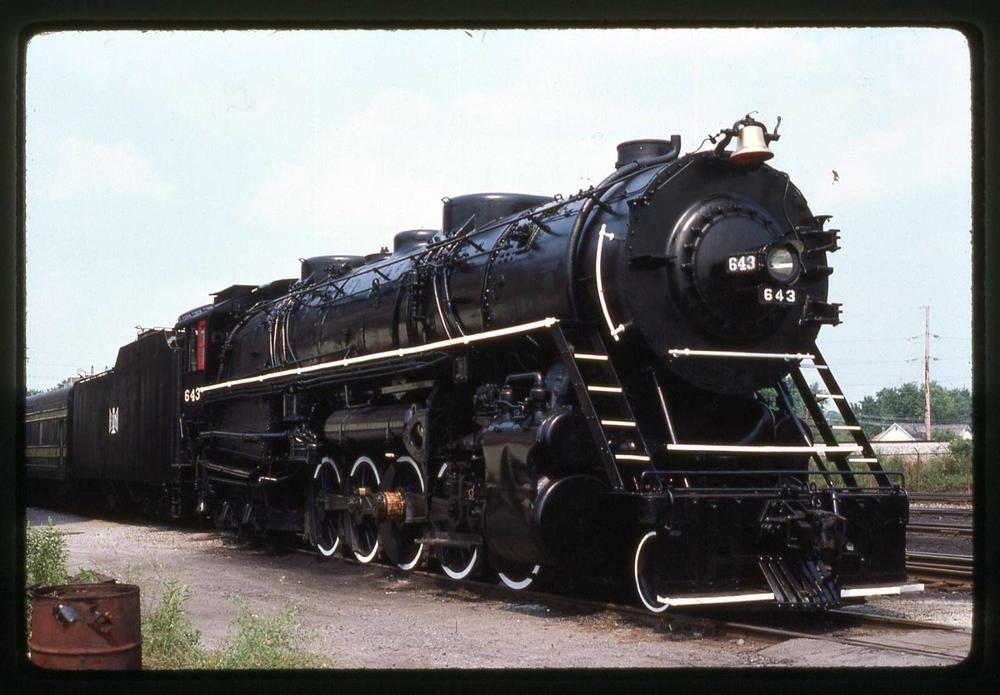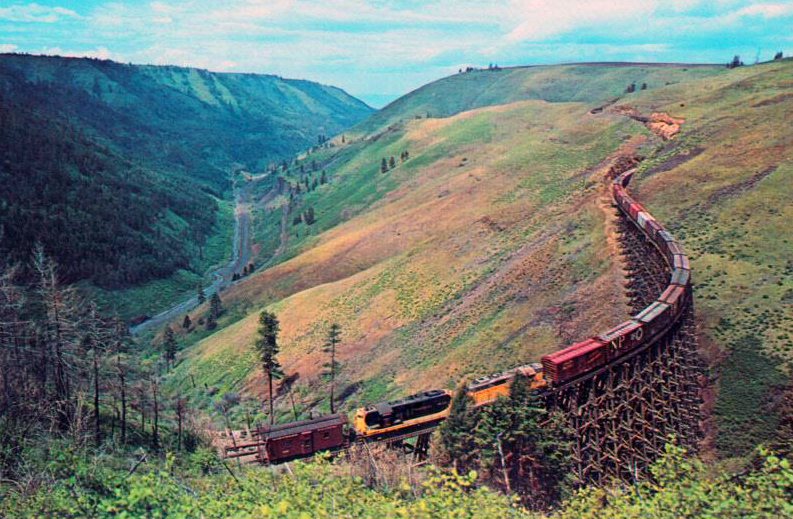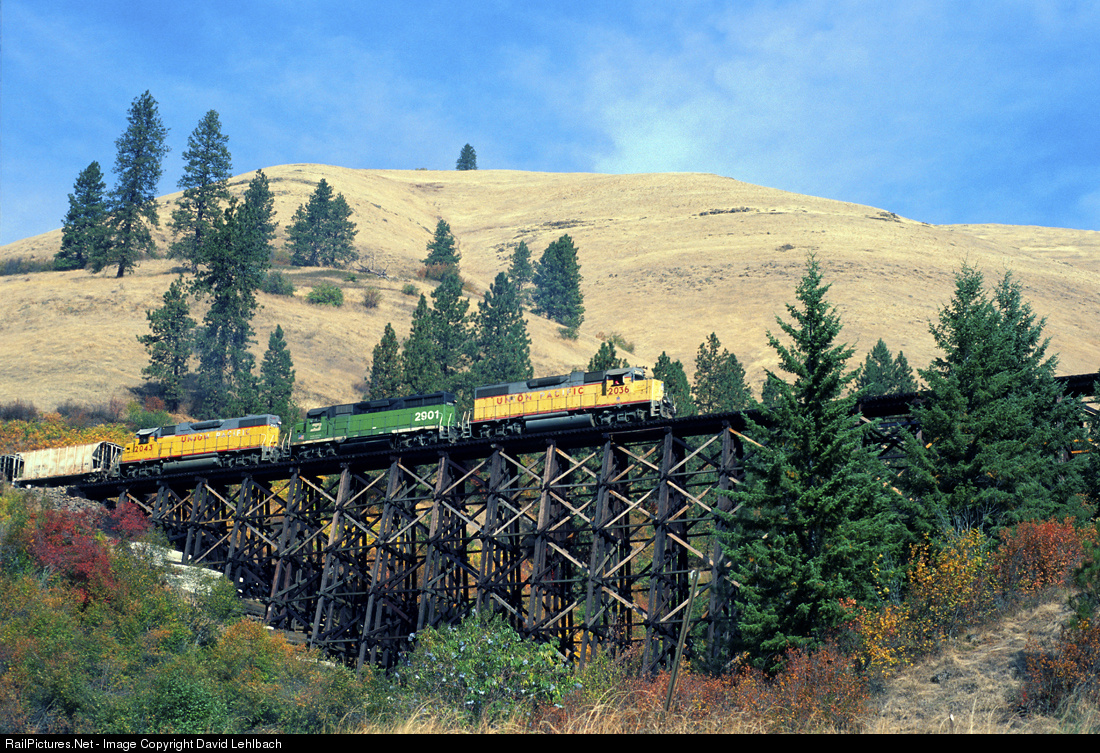In reply to Pete Gossett :
I regret I can only give your crazy train post a single thumb's up.

Bessemer & Lake Erie #643. Glad to hear that this engine is finally going to a good home. It looked touch and go for a while.


Built in '29 as part of the B&LE's mammoth H-1 class 2-10-4 Texas locomotives, the #643 has a total length of 95 feet and a weight of 906,000lbs, making it supposedly the largest and heaviest non-articulated steam locomotive in the US. In '52, the B&LE began to dieselize and all of their 47 H-1s, sans #643, were cut up. The B&LE set the #643 and 2 other locomotives aside and stored them in their roundhouse as display pieces.
In the 1980s, the B&LE decided to sell off the 3 steam locomotives and Steamtown, pre-government era, began bidding on the #643, with plans to move it up to the original Bellows Falls site. But a gentleman by the name of Glenn Campbell outbid him and took ownership of the #643 and moved it to the old Union Railroad shop in Hall, PA, where it was stored until 1993. At that point it was moved to the ex-Pittsburgh & Lake Erie shops in Mckees Rock, PA. Around this time, Glenn Campbell began a restoration to make the #643 operational and use for hauling excursions. At some point the locomotive was moved on compressed air, to prove it was operational, and it was also steamed up at another point.
The #643 found itself all dressed up, with nowhere to go though. Far too large and heavy, most railroads couldn't host the engine because of it's extreme length and inflexibility. It needed a relatively straight line to operate on, being non-articulated. Those that could accomodate it's size were leery of it's sheer weigh, nervous that it would tear up their tracks and roadbed. This gave the #643 the dubious honor of being the only steam locomotive to be restored to an operational condition but never turn a wheel in service.
Making the situation worse, it became landlocked when CSX instituted their "no vintage equipment" policy. And in '06, during a heavy snow storm cracks were found in the beams of the building she was stored in, leading to the building being torn down around it and leaving the #643 outside in the weather, as well as vulnerable to vandalism. By '18, the owner had thrown in the towel, tired of fighting a losing battle trying to keep the locomotive maintained, and the #643 went up for sale on eBay for $350,000, with the ultimatum of if it didn't sell it was getting cut up.
Again, due to it's sheer length, weight and landlock status, the general consensus was that the locomotive was all but cut up already. But at the eleventh hour, Age Of Steam Roundhouse came to the rescue and purchased the #643. As of now, they are slowly dismantling the engine and preparing to move it, in pieces, up to Sugarcreek, Ohio. Their statement on the engine is that while they want it in their collection due to it's claim to being the largest non-articulated locomoti ve, they have absolutely no intentions of mechanically restoring it and ever operating it again.
CP and CN both had 2-10-4's but they were called "Selkirks" up here after the Selkirk mountain range. They ran across the prairies from Revelstoke B.C. to Calgary and from Calgary to Swiftcurrent.

In reply to ShawnG :
As far as I know, the CP Selkirks were the only 2-10-4s that were regularly used in passenger service during their original career. Texas & Pacific #610 hauled part of the 1976 American Freedom Train and ran excursions from '76 to '82, but was strictly a freight hauler in her first life. T&P 610 is also the only 2-10-4 in North American to ever be restored to operation.


I always liked the Pennsylvania's big J1 2-10-4s. During WWII's traffic boom, the PRR needed a larger freight locomotive than their I1 2-10-0. But the War Production Board had a ban on railroads developing new locomotives. They could only build existing designs. I feel like this might have partly been aimed at the PRR, who loved to design and build their own designs and were fond of experimentation as well. Resources couldn't be wasted on experimental engines that didn't pan out, only existing proven designs. So, the PRR borrowed a Norfolk & Western A-class 2-6-6-4 and a Chesapeake & Ohio T-1 2-10-4 for testing. The PRR found the 2-10-4 to be what they wanted and began building 175 copies of the C&O T-1.


A giveaway that the J1 was not a PRR design was the lack of of a Belpaire boiler (Where they were squared off over the firebox), as well as Baker valve gear instead of the PRR's preferred Walschaerts. Also, seemingly miffed that they weren't allowed to design the whole engine, PRR did apply some cosmetic touches to make it their own compared to the C&O engine. They moved the sandbox from on top of the boiler to on the pilot. The headlamp was moved from the center of the smokebox door to the top of the boiler. The pilot was changed from foot boards to a cast-steel pilot with a drop coupler. And most interestingly, they designed a new cab with a streamlined side window that was unique to the J1. No other production PRR locomotive would feature that same cab, even ones that were streamlined or designed for passenger usage.
Also interesting is that the PRR gave them a keystone-shaped number plate. PRR gave keystone number plates to passenger locomotives, while freight locomotives were given a round number plate. There is no evidence that the PRR ever used the J1 in passenger service though. Perhaps it was just another effort to make the design theirs or maybe they had plans of using them on long-haul trains which never materialized.
The "War Babies", as they were nicknamed, were a successful design, being very powerful, and were well-liked by service. The PRR retired most of them in 1958 as they dieselized, and the remaining 25 were retired in '59. The PRR set none aside for preservation, which is odd because they saved at least one example of every one of their successful classes, from tiny 0-4-0s up to 2-10-0s. The consensus is, because the J1 was not designed by the railroad, they did not feel it was one of their locomotives, and thus not worthy of preservation. They also did not save any of the S1, Q1, Q2 and T1 duplexes, because they viewed them as failures.
No C&O T-1s were preserved either, so there isn't even the opportunity for a T-1 to be dressed up as a J1.
Old footage of PRR J1s, along with leased Santa Fe 5000-series 2-10-4s. The PRR had a power shortage in '56 in their Ohio district and borrowed some ATSF locomotives. I think my favorite part is at 3:20ish where the #5035' s bell has suffered some sort of weird failure and gone into whirl mode
Could some of the more memorable (re: storied) locomotives be built today from old plans (if they still exist) even if to be static display with their story for future generations..? Or would that be a futile excursion?
DjGreggieP said:Could some of the more memorable (re: storied) locomotives be built today from old plans (if they still exist) even if to be static display with their story for future generations..? Or would that be a futile excursion?
The Brits have built a few new steam locomotives, and currently in the US a group is building a brand-new PRR T1 from scratch.

Yeah, one of those things, a crazy non-articulated, streamlined 4-4-4-4 "Duplex". They are planning to have it done by 2030 and are making pretty solid progress on it. I'm surprised that no one has attempted to replicate a New York Central Hudson either, which would be much simpler undertaking than a T1. And on a smaller scale, they are using old 1940s blueprints still in Timken's archives, that the PRR had drafted as an experiment, to convert one of the PRR K4s to roller axle bearings.
In reply to T.J. :
It would definitely depend on the locomotive and the era it was built in. If you wanted to replicate a New York Central Hudson or Niagara, I'm sure the blueprints exist with some historical society. A New York, Ontario & Western V-class 2-6-0 or a Minneapolis & St. Louis 2-8-0 probably not so likely.
Nick, since you are an Alco fan:
At the Palouse, WA depot, HH-660 #66 switches a string of freight out of the interchange tracks. Overhead, a GN freight behind paired FA-1s approaches its own depot in September, 1956. Tom Kreutz photo.

The GN ran an interurban named "The Bug" between Spokane, WA, through Palouse, WA, then to Pullman, WA, Moscow, ID and eventually down to Lewiston, ID. Last service was in March 1966. Here's 'The Bug".

In reply to T.J. :
Interesting, you don't see many of the HH-series switchers. The S-series were much more commone.
T.J. said:The GN ran an interurban named "The Bug" between Spokane, WA, through Palouse, WA, then to Pullman, WA, Moscow, ID and eventually down to Lewiston, ID. Last service was in March 1966. Here's 'The Bug".
They tried running a passenger service across Syracuse with the old '50s Budd Rail Diesel Cars back in the '90s, called OnTrack. It was not successful for a bunch of reasons.
Syracuse had had old interurban train service but had closed it in the 1930s. In the 1990s they wanted to revive the service, and there was an old stretch of the DL&W that Conrail owned but no longer used, so they sold it to Onondaga County for $1. The county then leased the track to the New York, Susquehanna & Western and gave them a $4.5 million grant to purchase equipment and build passenger stations. The basic concept was to provide service between Syracuse University and Carousel Center (the huge mall) and then eventually the regional transportation center. The University-Carousel service never actually turned a profit, relying on volunteers and city grants. Then they tried to extend the line an extra half mile down to the William F Walsh Regional Transportation Center, which would have given them a connection to Amtrak trains and buses, as well as the baseball stadium and regional market, CSX threw a fit about them constructing a bridge over the CSX main line. The city had the $3 million set aside to build it, and the whole purpose was so that it didn't cross at a diamond and interfere with CSX traffic, but they said it might destabilize the adjacent CSX bridge. So, without the key stations, the program never really took off, and ridership declined, then the NYS&W was found to be using the state funds for OnTrack on their own equipment and freight services instead, and the whole thing got shut down.

One of the RDCs.

A view from the regional transportation center. In the very foreground, you can see where the rails were slated to go, as well as the platform that was constructed but never used.

The Carousel Center station.
Interestingly, the city is kicking around the concept of reviving OnTrack. Their theory is that the conversion of Carousel Mall to DestiNY USA (6th largest mall in the US) will be a bigger ridership draw, as will the addition of stations in lower-income neighborhoods, and the airport has offered to fund the construction of a line to the airport.
Since I've been on a binge studying the railroad history of Moscow, ID I figured I'd post some pictures of the famous Lapwai Canyon which is not too far away.




The triple-crossing at Richmond, VA. A C&O "Big Mike" 2-8-2 up top, a Seaboard Air Line F-unit below, and a Southern RS on the bottom.
Camas Prairie Railroad. That half moon trestle is wood. That area is not one you'd expect anyone would be crazy enough to build a railroad through. UP and BN shared it, so there are photos of trains with power from both roads on the same train.

You'll need to log in to post.